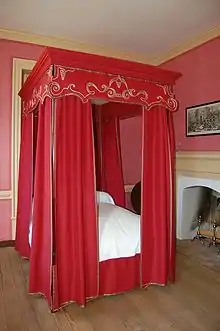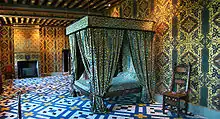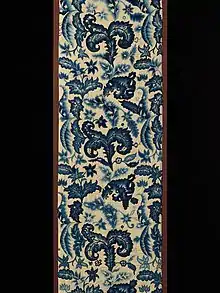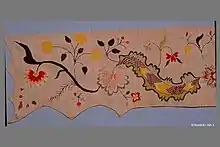Bed hangings
Bed hangings or bed curtains are fabric panels that surround a bed; they were used from medieval times through to the 19th century. Bed hangings provided privacy when the master or great bed was in a public room, such as the parlor. They also kept warmth in, and were a way of showing one's wealth. When bedrooms became more common in the mid-1700s, the use of bed hangings diminished.
Bed hangings were made of various fabrics, depending on the place, time period, and wealth of the owner. Fabrics included wool, cotton, linen, fustian, and, for those who could afford it, silk or velvet. Stitches were worked in wool or, for the rich or the nobility, silk and gold. Decorations on bed hangings also varied based on geography and time period. French hangings during the Renaissance might depict embroidered scenes from the Bible, mythology, or allegory. Hangings from the UK used floral, leaf, chinoiserie, and animal themes at various times, and those from the American Colonies often followed suit, though with less dense stitching to preserve scarce crewel wool. Examples of bed hangings can be found in museums and historic homes.

Purpose
Bed hangings, also known as bed "furniture," were used from medieval times[1] through the 19th century, though their popularity waned from the mid 1700s. Bed hangings proved useful for several reasons. The master bed was often located in the parlor, and the hangings provided privacy. Other beds may have occupied the hall and kitchen, as well as the upstairs bedrooms.[2] Given the public locations of some beds, the decorated hangings also served as a show of wealth[3] and helped to keep warmth in.[4] Bed hangings in the second half of the 1600s through the first half of the 1700s were often embroidered with Jacobean motifs in crewel wool. By the mid-18th century, separate rooms for sleeping were becoming more common, and the need for bed hangings diminished.[3]
Categories of bed hangings
A complete set of bed furniture would include a coverlet (not technically a bed hanging), "a headcloth, three or four valences (depending on whether the bed was against the wall), side curtains, a tester cloth (canopy), and bases, attached to the bed rail."[5]
.jpg.webp)
Headcloth (or Head cloth): this would hang above the head of the bed and extended just below the head board. It would normally be as wide as the bed. If there was extra width, it may have been designed to be wrapped around the bed posts.[6]
Valences: these short pieces of fabric would extend around the top of the bed, outside of the other hangings, and would lie perfectly flat. They were the "crowning element in a set of bed hangings." They were usually in three pieces, one for each side and one for the bottom of the bed, but by the late 1700s a valence might be one long piece.[7]
Side curtains: these would hang on both sides of the bed, and be used to cover the upper half of the bed.[8]
Tester cloth: the canopy for the bed (the word tester was occasionally used to mean the headcloth)[9]
Foot curtains: these would be wider than the side curtains. They would be pulled both toward the center sides of the bed, to meet the side curtains, and towards the foot of the bed, to meet in the center across from the headcloth.[8]
Bases: These would often be stiff, and used to cover the lower bed frame.[10]
Materials
English bed curtains were often made of wool, though in the mid 1600s linen and cotton fabrics started to be used, particularly fustian, a heavy twill-woven cloth with a linen warp and a cotton weft.[11] In the late 1600s those who could afford it might use silk and velvet fabrics.[12] Colonial American bed hangings were often made of home-grown linen or from local wool. These would be spun, dyed and woven, though finer fabrics were available for purchase.[13]
Needlework decorations
Continental bed hangings
Embroidery was used to decorate bed hangings, with some of the finest embroidery produced in Caen, in France. Elaborately decorated bed hangings were known in medieval and renaissance France as courtepointerie, a term now associated with quilts. These sumptuous bed hangings were purchased by the nobility and royalty.[14] In 1662, during the reign of Louis XIV, the royal Gobelins workshops were established. Although better known for their tapestries, there and at Versailles, professional embroiderers worked on royal commissions of bed hangings based on the designs of painters. [15] During the Renaissance in France, bed valences were embroidered with scenes from the Bible, mythology, and allegory.[16] Many bed hangings were made from velvet or satin and had applique interlacing and scroll designs. These motifs full of movement, as well as others that were delicate and refined in the 16th century were followed in the next by a more monumental style produced by professionals. Those of the highest quality were made by professionals.[17] Bed hangings were highly valued possessions, and records from the Middle Ages through the 1700s indicate that they were their owners' most prized possessions.[18]

In Italy, embroidered bed hangings had been made in Palermo since the 12th century.[14] Professional workers embroidered padded gold threads on velvet or satin, used braid-outlined appliqué, sometimes with silk embroidery for use as furnishings such as valences.[19] In the second half of the 17th century, lighter domestic embroidered work became more colorful, freer, and naturalistic.[20]
In 1512, Bona Sforza of Aragon married King Zygmunt I of Poland. As part of her trousseau, she brought a four poster marriage bed with 23 hangings attached to the canopy. One of the most expensive "was made of silver material with a gold border, woven with the stylized inflorescence of artichokes."[21]
English and Colonial American bed hangings
The most economical bed hangings were plain or mechanically decorated. Crewel embroidery with wool was used to decorate bed hangings in England and the colonial US from the mid 1600s to the mid 1700s.[22] The designs used in England were more dense than the open designs found in colonial America, and many used a wider range of stitches. Thread was hard to get in Colonial America, and so it was not used where it would not show. Colonial bed hangings used stitches where most of the wool is visible on the front, and not wasted on the back. Such stitches include economy (Romanian) stitch,[23] flat stitch, herringbone, buttonhole, running (outline), and French and bullion knot stitches. Regardless, the work involved a great deal of time and effort, as it required decorating large expanses of fabric.[13]

For bed hangings decorated at home, the colors of the embroidery depended on what was available for use, or what could be dyed. Those who had access to a full range of colors could embroider realistic floral designs, while others would select or be limited to a monochromatic color scheme. Blue and rose and blue and white were popular in the American colonies, with the blue dye coming from the household's indigo pot.[24] The designs used varied with the country and the time period. Elizabethan designs had scrolling vines and animal patterns, Jacobean designs might be predominantly leaves. About the turn of the 17th century, chinoiserie design elements became popular. By the mid 1700s, designs were more natural and included pictorial elements, such as animals.[25]

Artifacts
It is possible that few pieces of 17th century crewel bed hangings survive because women did not have the leisure time to work on them.[4] More have survived from the 18th century. Few full sets of bed hangings were passed down intact, because their worth often meant they were divided amongst surviving heirs.[26] In the New England in the US, the great bed and its hangings went to the eldest son, but if the bed hangings were embroidered, the bed might go to the eldest son and the hangings would be divided amongst the other children.[27] Some pieces that still exist may never have been part of a full set. Later in the Colonial period some sets of hangings were smaller, including only side curtains at the head of the bed and valances.[28]
Examples
In Great Britain, the Oxburgh Hangings, hanging in Oxburgh Hall, were embroidered by Mary Queen of Scotts and Bess of Hardwick between 1570 and approximately 1585. Anne Boleyn embroidered a tester for Henry VIII.[29]
In the United States, the only complete set of embroidered bed hangings are those made by Mary Bulman, most likely in the 1730s, which are housed in the Old Gaol Museum in York, Maine.[30] This set includes "four curtains, a coverlet, a headcloth, tester, outer valences, and inner valences."[31] These inner valences contained an embroidered poem by Isaac Watts, "Meditation in a Grove." These valences would hang inside the bed curtains, where they could be read while in bed. When Mary's husband died in 1745, his probate inventory listed the value of the bed hangings as 20 pounds, which was the same amount as a 10-acre piece of land also in the inventory.[31]
A set of bed hangings donated to the Museum of Fine Arts, Boston by Samuel Bradstreet, a descendant of the early American poet Anne Bradstreet, were worked in crewel in a pattern of large floral designs, and were likely made in the second quarter of the 1700s.[32]

The New Elizabethan Embroidery Project created a new set of bed hangings in the Elizabethan style for the 16th century bed in the Grand Tudor chamber in Sulgrave Manor, the ancestral home of George Washington, the first president of the United States. Completed in 2007 by stitchers in both the US and the UK, the designs were inspired by motifs and symbols found elsewhere in the house.[33]
The Rijksmuseum in Amsterdam has an almost complete set of 18th-century Chinese silk embroidered bed hangings, missing only the tester and the headboard. The designs include peacocks, flowering vines, foliage, butterflies, and vases of flowers. Created for the export trade, the set is extremely luxurious and was designed for a state bed, one meant to be seen. [34]
Notes
- Bishop & Coblentz 1979, p. 27.
- Cummings 1961, p. 2.
- Needle arts 1990, p. 57.
- Hedlund 1967, p. 9.
- Needle arts 1990, p. 64.
- Cummings 1961, p. 51-52.
- Cummings 1961, p. 54-55.
- Cummings 1961, p. 52.
- Townsend 1942, p. 112.
- Hughes 1961, p. 121.
- Rowe 1973, p. 105.
- Bridgeman & Drury 1978, p. 87.
- Hedlund 1967, p. 11.
- Campbell 2003.
- Parker et al. 1989, p. 27.
- Bridgeman & Drury 1978, p. 92.
- Bridgeman & Drury 1978, p. 100-101.
- Synge 1982, p. 25.
- Bridgeman & Drury 1978, p. 137.
- Bridgeman & Drury 1978, p. 139.
- Morka 2008, p. 72.
- Rowe 1973.
- Bath 1979, p. 91.
- Davis 1969, p. 38,56.
- Rowe 1973, p. 105-111.
- Parmal 2012, p. 47.
- Bogdonoff 1975, p. 82.
- Rowe 1973, p. 104.
- Hughes 1961, p. 120.
- McDermott, Deborah. "Bulman bed hangings back at Old York". seacoastonline.com. Retrieved 2020-12-10.
- Parmal 2012, p. 61.
- Parmal 2012, p. 58.
- "Sulgrave Manor: Ancestral home of First US President George Washington". Discover Britain. 2015-01-30. Retrieved 2020-12-12.
- Hartkamp-Jonxis 2013.
References
- Bath, Virginia Churchill (1979). Needlework in America: History, designs, and techniques. New York: Viking Press. ISBN 0-670-50575-7. OCLC 4957595.
- Bishop, Robert; Coblentz, Patricia (1979). Furniture 1. Washington, DC: Smithsonian Institution.
- Bogdonoff, Nancy Dick (1975). Handwoven textiles of early New England: The legacy of a rural people, 1640-1880. Harrisburg, Pennsylvania: Stackpole Books. ISBN 978-0811707831. OCLC 3205784.
- Bridgeman, Harriet; Drury, Elizabeth (1978). Needlework: An illustrated history. New York: Paddington Press. ISBN 0-448-22066-0. OCLC 3843144.
- Campbell, Gordon (2003). The Oxford dictionary of the Renaissance. Oxford. ISBN 0-19-860175-1. OCLC 51009458.
- Cummings, Abbott Lowell (1961). Bed Hangings: A Treatise on Fabrics and Styles in the Curtaining of Beds 1650-1850. Boston: The Society for the Preservation of New England Antiquities.
- Davis, Mildred J. (1969). Early American Embroidery Designs. New York: Crown.
- Hartkamp-Jonxis, Ebeltje (2013). "Sleeping in Style: Chinese Embroidery and Other Bed Furnishings 1770-1850". The Rijksmuseum Bulletin. 61 (2): 172–197. ISSN 1877-8127.
- Hedlund, Catherine A. (1967). A Primer of New England Crewel Embroidery. Sturbridge, Massachusetts: Old Sturbridge Village.
- Hughes, Therle (1961). English Domestic Needlework. London: Abbey Fine Arts.
- Morka, Mieczysław (2008). "The Beginnings of Medallic Art in Poland during the Times of Zygmunt I and Bona Sforza". Artibus et Historiae. 29 (58): 65–87. ISSN 0391-9064.
- The Needle arts: A social history of American needlework. Alexandria, Va.: Time-Life Books. 1990. ISBN 0-8094-6841-7. OCLC 21482166.
- Parker, James; Zrebiec, Alice M.; McNab, Jessie; Le Corbeiller, Clare; Vincent, Clare (1989). "French Decorative Arts during the Reign of Louis XIV 1654-1715". The Metropolitan Museum of Art Bulletin. 46 (4): i–64. doi:10.2307/3269195. ISSN 0026-1521.
- Parmal, Pamela A. (2012). Women's work: Embroidery in colonial Boston. MFA Publications (1st ed.). Boston: Museum of Fine Arts, Boston. ISBN 978-0-87846-778-5. OCLC 796084579.
- Rowe, Ann Pollard (1973). "Crewel Embroidered Bed Hangings in Old and New England". Boston Museum Bulletin. 71 (365–366): 102–166.
- Synge, Lanto (1982). Antique needlework. Poole, Dorset: Blandford Press. ISBN 0-7137-1007-1. OCLC 8811623.
- Townsend, Gertrude (1942). "A Set of Eighteenth Century Embroidered Bed Curtains". Bulletin of the Museum of Fine Arts. 40 (242): 111–115 – via JSTOR.
